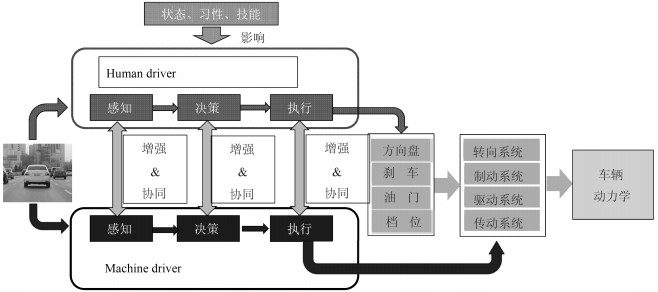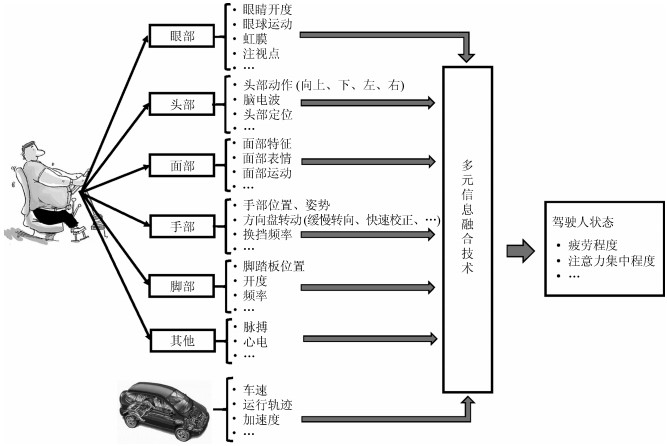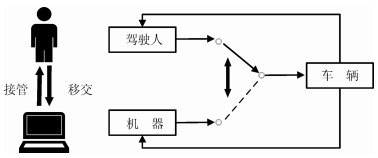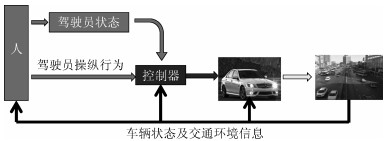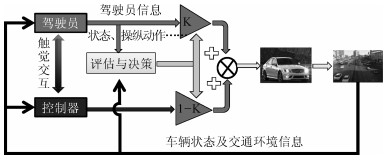Human-machine Cooperative Control of Intelligent Vehicle: Recent Developments and Future Perspectives
-
摘要: 随着人工智能、互联网技术、通信技术、计算机技术的快速发展,以电动化、智能化及网联化为基础的智能汽车成为汽车行业发展的一大趋势.按照汽车智能化、自动化的发展进程,美国汽车工程师协会将智能汽车的发展分为手动驾驶、驾驶辅助、部分自动化、有条件自动化、高度自动化和完全自动化6个级别,虽然不同层次、不同功能的汽车智能化技术正迅猛发展,但是真正意义上的全工况自动驾驶在短期内很难实现.因此,在未来很长一段时期内,智能汽车必然面对人机协同控制的局面,本文详细介绍了智能汽车人机协同控制中驾驶员建模及人机驾驶权动态优化控制的国内外研究现状,同时简要介绍了智能汽车测试与评价的国内外研究现状,提炼了共性问题,并对人机协同控制的发展趋势给出了一些观点.Abstract: With the rapid development of artificial intelligence, information and communication technology, intelligent vehicle oriented toward electrical, intelligence and network techniques becomes one of the major trends in the automotive industry. The society of automotive engineers (SAE) divides intelligent and autonomous vehicle technologies into six levels:manual driving, driving assistance, partial automation, conditional automation, highly automation and fully automation. Although intelligent and autonomous vehicle technologies at different levels and different functions are developed rapidly, it is very difficult to implement automatic driving in the near future. Therefore, intelligent and autonomous vehicle has to face the situation of human-machine coordinated control in a long period of time. This paper focuses on the research status and future perspectives of driver modeling, cooperative control strategy and test and evaluation of intelligent vehicle, in which the common problems are extracted and some views on the development trends of human-machine cooperative control are given.
-
城市轨道交通具有安全、准时、快速、运量大等优点, 在解决城市拥堵、促进城市及其交通可持续发展方面发挥着重要作用[1].基于通信的列车运行控制(Communication-based train control, CBTC)是城市轨道交通信号系统的关键技术, 该技术使用无线通信实现列车与地面设备的实时、双向、连续信息交互, 控制列车的运行速度和方向, 在确保安全的前提下提高城市轨道交通的运行效率[2].为提升城市轨道交通的自动化和信息化水平, 通信、控制、计算机等信息技术在CBTC系统中得到了广泛应用.与此同时, 来自系统外部或内部的信息攻击的威胁加大, 系统面临的挑战日益严峻[3], 信息安全事件频发. 2012年3月, 上海申通地铁车站信息发布系统和运行调度系统的无线网络受到攻击; 2012年7月, 深圳地铁受乘客随身MIFI (Mobile WIFI)干扰的影响导致车地通信中断, 致使多列列车紧急制动等.这些事件均造成了不好的社会影响, 有的严重影响了城市轨道交通的行车秩序. CBTC系统的信息安全已成为轨道交通领域的重要研究内容, 评估列控系统网络安全性、提高CBTC系统信息安全防护能力成为轨道交通事业健康、快速发展的关键[4].
然而, 国内外对轨道交通领域的信息安全研究处于起步阶段, 相关研究停留在列控系统信息安全存在的隐患及挑战等分析层面, 针对CBTC系统的信息安全评估方法匮乏.文献[5]对欧洲铁路运输(European railway traffic management system, ERTMS)规范中的潜在漏洞进行分析, 并综合威胁来源、攻击能力以及影响等级几个方面定性地评估了英国实施的 ERTMS 的网络安全风险.文献[6]采用基于贝叶斯攻击图的方法, 分析了列控系统最易发生的信息安全事件及系统的风险等级.文献[7]分析了用于控制道岔转换、改变行车信号的先进列车控制系统(Advanced train control systems, ATCS)协议的脆弱性.文献[8-9]分别从入侵检测和攻击防御的角度对列控系统信息安全进行研究.
鉴于CBTC系统与其他工业控制系统(Industrial control system, ICS)均属于典型的信息物理系统(Cyber physical system, CPS)[10], 例如智能电网[11]、水利[12]、核能[13]等, 加之这些领域对信息安全的研究相对成熟, 因此, CBTC系统信息安全研究可参考ICS相关的研究方法及成果.
常见的信息安全评估方法有贝叶斯网络、攻击树、Petri网、博弈论等.贝叶斯网络[14-15]是一种将定性分析转化为定量分析的概率网络, 文献[16]提出了一种基于贝叶斯网络的网络安全模型, 从管理和技术方面综合评估了核基础设施的安全性.考虑到贝叶斯网络具有解决复杂依赖性问题的优势, 文献[17]利用贝叶斯网络计算结果作为事件树的输入, 分析网络攻击下核反应堆保护系统的故障率, 从而量化评估其信息安全能力.该方法克服了常见的概率安全评估方法在工业控制系统信息安全评估中的局限性.攻击树[18-19]可以方便直接地显示系统中的资产或设备可能受到的攻击类型, 提供了一种以目标为导向的方法来描述多阶段攻击, 文献[20]基于攻击树对节点重新定义, 从各设备、攻击场景及系统的脆弱性的角度对SCADA (Supervisory control and data acquisition)系统的安全性进行评估, 但是, 该方法是一种静态的信息安全评估方法, 不能体现系统在网络攻击中状态的变化. Petri网[21-22]中的变迁是一个主动元素, 可以表示事件发生、状态改变等动态特性, Bouchti等 [23]提出了一种将静态的攻击树模型扩展为有色Petri网的方法, 利用有色Petri网[24-25]的灵活性, 分析网络入侵的静态和动态特征.信息安全攻防之间构成典型的博弈关系, 使用博弈论[26-27]研究信息安全问题较为广泛, 加之许多信息安全评估方法只关注系统当前的安全状态, 没有考虑未来系统安全状态的变化趋势, 文献[28]提出了一种基于马尔科夫博弈理论的新型风险评估模型以衡量网络信息系统的安全性, 并且能自动生成防御方案以提高系统信息安全防护能力.
上述方法均从系统的执行流程出发, 基于功能和性能对信息安全防护能力进行评估.然而, 信息安全风险总是从计算机网络发起, 然后在工业控制系统中演化, 最终作用于物理系统.上述方法难以对风险传播过程中的系统性能进行综合刻画. Li等[29], 提出了首个衡量网络结构信息的方法, 即二维结构熵, 并基于该方法提出了网络阻力的概念, 用以定量描述网络面对病毒传播时的抵抗能力[30], 克服了传统的Shannon信息熵无法充分反映网络结构信息的局限性[31].
本文基于二维结构熵提出衡量CBTC系统网络结构性能的方法, 再结合物理域列控系统的运行性能, 给出了CBTC系统信息安全的定量描述模型, 最后依托CBTC信息安全测试床对该方法的准确性和有效性进行验证.
1. CBTC系统
1.1 CBTC系统简介
典型的CBTC系统如图 1所示, 核心装备包括列车自动监控(Automatic train supervision, ATS)、区域控制器(Zone controller, ZC)、计算机联锁(Computer interlocking, CI)、车载控制器(Vehicle on-board controller, VOBC)、数据存储单元(Data storage unit, DSU)和数据通信系统(Data communication system, DCS).
列车运行过程中, VOBC通过车载移动台(Mobile station, MS)不间断地将列车标识、实时位置、速度及运行方向等信息传输给ZC. ZC根据接收到的列车信息以及CI监测的线路信息实时动态计算后车可到达的最远距离, 即移动授权(Movement authority, MA), 并发给后车, 后车根据接收到的MA计算列车运行曲线并按照该曲线行驶, 在这一过程中, 列车到ZC和ZC到列车之间的信息交互均通过车地无线通信实现.
1.2 CBTC系统的信息安全问题
目前已投入运营的CBTC系统主要采用基于IEEE 802.11协议族的无线局域网作为车地通信的主要制式.为提升信息化和自动化程度, CBTC系统采用大量数字化和信息化组件, 包括Windows和VxWorks等操作系统、通用计算机、标准通信协议等.然而, 随着系统组件漏洞的逐渐披露, CBTC系统面临着日益严峻的信息安全风险.一旦系统被恶意入侵, 漏洞被利用, 列车会被迫紧急制动, 降低系统运行效率, 影响正常行车秩序.
CBTC系统的典型信息安全风险包括: 1)网络设备的工作机制、配置等信息安全隐患可能被内部及外部威胁利用, 例如常用的防火墙设备的包过滤机制存在缺陷, 可导致防火墙被穿透; 2)核心、汇聚交换机承载着极高的数据流量, 在突发异常数据或攻击时, 极易造成设备负载过重而宕机; 3)操作系统漏洞会导致远程代码执行、缓冲区溢出、拒绝服务、信息泄露、未授权访问以及获取权限等, 均可给城市轨道交通的高效运营带来极大隐患; 4) WLAN工作在ISM频段, 易受到干扰, 其认证、加密等关键技术相对陈旧, 车地信息的传输存在被窃听甚至篡改的风险, 对行车效率造成威胁.
实际上, CBTC系统的安全苛求特征决定系统具有比较完善的安全功能防护措施, 包括故障导向安全机制、容错架构设计、冗余设置、安全协议等.然而, 功能安全保障措施并非专为信息安全设计, 既有措施对信息安全风险的约束以及信息安全风险造成的影响仍需要精确、全面评估.
2. CBTC系统信息安全评估方法
信息物理系统中, 信息安全威胁和系统漏洞组合作用于信息域的网络节点或链路, 进而会引起物理域列车运行状态的变化, 从而带来轨道交通运营服务性能的降低.综合描述物理域和信息域的性能是对CBTC系统信息安全风险评估的核心, 本文引入结构信息熵对计算机网络在信息安全风险下的整体性能进行描述和分析, 继而充分考虑物理域列车控制性能, 实现对CBTC系统信息安全风险的综合评价.
2.1 二维结构熵
Shannon提出的熵是关于不确定性的一种度量, 结构信息熵可用来描述复杂系统结构的属性.网络的结构信息能够较好地定义网络交互、网络通信以及网络演变等网络结构的动态复杂性, 对网络理论的发展至关重要[32].因此, 借助于二维结构熵可描述计算机网络在信息安全风险下的状态变化.
2.1.1 二维结构熵的定义
给定一个由$n$个节点和$m$条边组成的连通的加权网络$G=(V, E), V$和$E$分别是网络$G$中所有节点和所有边的集合, 将$V$划分为$L$个模块, 每个模块用$X_{j}$表示, 则$P=\{X_{1}$, $X_{2}, \cdots$, $X_{L}$可看作$G$的划分.由于$P$的存在, 确定$G$中任意一点$v$ $\in$$V$都需要确定$v$所在的模块的标识$j$和$v$在相应模块$X_{j}$中的节点标识$i$.基于划分$P$, 给出网络$G$的二维结构熵的定义, 如下:
$ \begin{array}{l} {H^2}(G) = {\mkern 1mu} \sum\limits_{j = 1}^L {\frac{{{V_j}}}{{vol(G)}}} \times H\left( {\frac{{d_1^{(j)}}}{{{V_j}}}, \cdots ,\frac{{d_{{n_j}}^{(j)}}}{{{V_j}}}} \right) - \\ \sum\limits_{j = 1}^L {\frac{{{g_j}}}{{vol(G)}}} {\rm{lo}}{{\rm{g}}_{\rm{2}}}\frac{{{V_j}}}{{vol(G)}} = \\ - \sum\limits_{j = 1}^L {\frac{{{V_j}}}{{vol(G)}}} \sum\limits_{i = 1}^{{n_j}} {\frac{{d_i^{(j)}}}{{{V_j}}}} {\rm{lo}}{{\rm{g}}_{\rm{2}}}\frac{{d_i^{(j)}}}{{{V_j}}}{\mkern 1mu} - \\ \sum\limits_{j = 1}^L {\frac{{{g_j}}}{{vol(G)}}} {\rm{lo}}{{\rm{g}}_{\rm{2}}}\frac{{{V_j}}}{{vol(G)}}\\ \end{array} $
(1) 其中, $d_i^{(j)}$表示模块$X_j$中第$i$个节点的度, $vol(G$)和$V_j$分别表示网络$G$及模块$X_j$中所有节点的度之和, $n_j$表示$X_j$包含的节点数, $g_j$表示有且只有一个端点与$X_j$中节点相连的边数.
$H^{2}(G)$是一个二项式, 第1项表示在模块$X_j$中确定任意节点$v$所需要的信息量; 第2项表示在$G$中, 确定某一模块$X$所需的信息量.其中, 每个模块可由与其相连的其他模块中的节点访问.因此, 二维结构熵包含了各个模块内部节点的信息和各模块之间的信息, 反映了系统网络拓扑结构的特性.
2.1.2 系统二维结构熵的特点
CBTC系统的计算机设备和网络设备构成了典型的计算机网络, 设备之间存在复杂的数据交互.由于城市轨道交通站间距离短, 所以CBTC装备分布密度高, 同时系统的冗余和容错设置也使得网络中的设备数量众多.鉴于安全等级需求和工作模式的不同, 数据交互的承载方式有所不同, 传输协议和传输媒介存在差异.
二维结构熵定义中图的顶点和边均是一致的, 而CBTC网络中的节点和通信链路有一定的差异性, 因此对网络拓扑的顶点和边的属性的差异性需要针对性描述.本文使用加权网络对CBTC网络拓扑的顶点和边进行加权处理.
1) 边权重
网络拓扑中的边即为通信链路, CBTC系统中, 通信链路以有线和无线两种形式呈现.有线网即为骨干网, 采用数字同步序列、弹性分组网或基于交换技术的环网, 地面设备通过骨干网基于TCP/IP通信协议交互数据; 无线是地面设备与车载设备的双向数据传输方式, 主要承载列车和地面控制中心的信息交互.考虑到数据传输的安全需求不同, 不同通信链路采用不同的应用层传输协议.典型的CBTC系统安全通信协议包括RSSP-I、RSSP-II以及私有协议等, 不同协议的安全防护能力不同, 各自的权重值也不同.类似地, 考虑到通信链路的本质物理属性, 有线网和无线网的抗干扰能力及安全防护能力不同, 各自的权重值也不同.
2) 节点权重
CBTC系统主要的通信节点有安全计算机、工控机、服务器、网络交换机、网关等, 根据功能定位的不同, 内置的操作系统也不同, 主要有, WindowsXP、Windows7、Windows Server以及VxWorks等.鉴于设备类型、设备配置及使用的操作系统等的多样性, 每个设备的安全隐患有所不同, 例如使用防火墙及强登录密码的设备的安全性要高于未设置防火墙及身份验证的设备; Windows操作系统的漏洞一般远多于VxWorks系统; 相同操作系统的设备的漏洞数目、严重程度也可能不同等.因此, 在构建CBTC网络拓扑图时, 需要考虑通信节点的安全性差异从而给各个顶点赋权重, 权值的大小取决于设备现有的安全措施、是否存在异常、漏洞情况等.
一般而言, 边的安全性越低, 与其连接的节点被入侵的可能性越高, 但是节点被入侵的可能性还取决于节点自身的特性.如果节点本身安全性很高, 即便与其相连的边易被入侵, 该节点被攻击成功的可能性也会降低.
CBTC加权网络与一般的加权网络相比, 除了边被赋予权重, 网络的节点也被赋予不同的权重, 因此, 各节点的度不能仅由边权重之和确定, 应具有其特殊性.由此, 给出CBTC系统在节点度的新定义如下:
$ \begin{align} d_i^{j}=\sum\limits_{k_i=1}^{E_i^j}we_{k_i}^j \times wn_{i}^j \end{align} $
(2) 其中, $we_{k_i}^j$表示第$j$个模块中与节点$i$相连的第$k$条边的权重, $wn_{i}^j$表示第$j$个模块中节点$i$的权重, $E_i^j$表示第$j$个模块中与节点$i$相连的总边数.
2.2 列车运行性能
二维结构熵衡量的是CBTC系统信息域网络拓扑在信息安全风险下的状态变化, 无法体现物理域列车的运营属性, 因此需要在式(1)的基础上增加列车运行性能的参数.
列车按计划正常行驶时, 线路的运营能力、列车的运行速度和运行距离等指标在一定范围内随时间规律变化.基于故障导向安全原则, 为保证安全, 在信息安全风险作用下, 列车运行会导向安全侧, 即列车紧急停车.为了保障列车运行的连续性和线路运营服务的弹性, 列车停车后会进行降级运行, CBTC系统的冗余和容错架构设计会使得即使在某些情况下网络的拓扑性能发生改变, 列车运行仍不受影响.因此在衡量CBTC系统的信息安全风险时, 需要综合考虑物理域的列控性能和信息域的网络性能.
以车地通信为例, ZC与车载设备通过骨干网实现无线双向通信, 由于ZC采用$2\times2$取2的架构, 当ZC主系故障时会自动切到备系以确保列车仍能收到MA并正常运行.因此, 攻击者攻击ZC时, 列车运行状态在短时间内不会受到影响; 随着攻击的深入, ZC备系也故障时, 列车则触发故障, 安全机制, 紧急制动; 在制动过程中, 如果列车满足降级运行, 即通过一个用于定位的应答器时, 列车会重新启动, 由自动驾驶模式转换为点式运行模式.如图 2所示, 面临信息安全风险时, 冗余设计使得CBTC系统具备一定的抵抗力, 当主备系均被破坏后, 列车性能开始由最佳状态快速下降直至最低点, 在保障功能安全的前提下, 根据运营服务的需求, 列车性能开始缓慢恢复, 最终达到新的稳定状态.由于网络攻击前后列车驾驶模式发生改变, 因此, 初始的列车运行性能状态优于缓慢恢复后的新的稳定状态.
上述过程导致列车的实际运行曲线与计划运行曲线产生较大差异, 图 2中的阴影部分是信息安全风险下系统性能的损失, 可由列车实际运行速度曲线计算得到.
$ \begin{align} P_{\rm loss}(t)=\int_{t_0}^{t}(v_p-v_a){\rm d}t \end{align} $
(3) 其中, $P_{\rm loss}(t)$表示$t$时刻列车运行性能损失, $t_0$表示初始时刻, $v_p$和$v_a$分别表示列车计划和实际运行速度.对式(3)进行归一化处理可得
$ \begin{align} P(t)=\int_{t_0}^{t}\frac{v_p-v_a}{v_p}{\rm d}t=\int_{t_0}^{t}\left(1-\frac{v_a}{v_p}\right){\rm d}t \end{align} $
(4) $P(t)$, 范围为[0, 1], 值越小, 表示攻击对列车当前时刻造成的影响越大.
2.3 系统信息安全模型
有效的网络攻击会对CBTC系统信息域的网络拓扑性能造成直接影响, 例如利用特定系统漏洞导致设备宕机继而节点从网络中移除, 利用协议漏洞导致设备通信中断继而使相应节点之间的边移除等.但是CBTC系统采取双网冗余、双机热备等架构设计, 确保了列控系统在一定程度上具有抵抗网络攻击的能力, 即随着网络攻击致使系统的网络拓扑结构造发生变化, 但列车仍能在短时间内保持CBTC驾驶模式正常运行.因此, 衡量CBTC系统的信息安全状态需要综合信息域网络拓扑性能及物理域列车运行性能, 继而得到衡量CBTC系统信息安全的模型.
考虑到网络攻击可能使子系统之间通信中断, 从而导致系统网络拓扑结构由连通状态变为非连通, 因此, 结合前面给出的CBTC系统在网络攻击过程中信息域及物理域的动态评估结果, 可得CBTC系统信息安全模型.
$ \begin{align} S(t)=&\ H_t^2(G) \times P(t)=\nonumber\\&\ \frac{1}{vol(G)} \sum\limits_{k=1}^{N}vol(G_k)H_t^2(G_k)P(t) \end{align} $
(5) 其中, $N$, 表示当前网络结构中连通子图的个数, $vol(G_k)$表示$t$时刻系统网络结构中第$k$个连通子图中所有节点度之和, $H^{2}_t(G_k)$表示$t$时刻该连通子图的二维结构熵; $P(t)$表示$t$时刻列车运行情况.
3. CBTC系统信息安全评估方法验证与分析
本节基于CBTC系统信息安全测试床, 利用系统的安全隐患模拟入侵者对其进行网络攻击.根据信息安全评估模型, 构建CBTC系统的网络拓扑, 分析网络边和节点的权重并计算网络拓扑性能的变化, 根据列车运行状态计算列车性能的变化, 综合评估测试床的安全性.
3.1 CBTC系统信息安全测试床
CBTC系统信息安全测试床是基于北京地铁7号线搭建的列控系统半实物仿真平台, 由部分真实列控设备、仿真软件和真实线路参数组成, 模拟多列车在线路上的追踪.
每个ZC子系统包含4台使用VxWorks系统的处理单元(Process unit, PU)、2台通信控制器(Communication controller, CC)以及1台使用Windows XP系统的维护机, 构成取2的容错架构.当且仅当主系或备系中的2个PU处理结果相同时, 才能作为本系的最终结果, 此外, 每一系的CC承载着骨干网与ZC内网数据转发的功能, 一旦CC故障, 相应的骨干网将无法接收来自ZC的数据.
CBTC测试床网络拓扑如图 3所示.按功能结构将拓扑图划分为15个子系统: 6个ZC子系统, 1个ATS子系统, 每个ZC覆盖范围内的所有AP, VOBC及MS, 各划分为1个子系统, 8个CI设备作为1个子系统, 其他设备例如地面电子单元(Lineside electronic unit, LEU)和DSU等作为1个子系统.
3.2 攻击案例
为了验证上述方法的合理性, 本文将ZC子系统作为攻击目标进行仿真实验.
ZC由主备两系组成, 每一系包括1台CC和2台PU, CC宕机后会自动重启, 若重启失败, 则整系宕机.
根据ZC的工作原理, 模拟以下攻击过程:如图 4所示, 首先攻击者通过暴力破解无线网密码侵入DCS红网, 通过网络分析获取网段信息, 随后利用VxWorks操作系统漏洞对ZC1主系的CC1发起攻击, 导致CC1宕机, 共耗时20, min; 持续攻击CC1, 使其重启失败, 则主系两个PU同时宕机, ZC1切换到备系, 共耗时10, min; 采用同样的方法接入蓝网, 攻击ZC1的备系, 直到整个ZC1子系统故障.对ZC2, ZC3依次进行上述操作.
3.3 CBTC系统信息安全评估结果及分析
3.3.1 网络拓扑性能变化
系统的设备故障反映到网络拓扑中表现为相应的节点从拓扑中移除, 因此, 系统的网络拓扑随着上述攻击过程不断变化.
1) 节点权重
节点的权重使用文献[33]中基于攻击树的脆弱性评估的方法, 构建 CBTC 测试床的攻击树模型, 综合每台设备, 即每个节点的安全状态、设备漏洞情况、密码强度以及涉及的通信协议类型4个要素计算得到.
$ v\left( L \right) = \chi \times {\rm{max}}\left\{ {{v_\alpha },{v_\beta }} \right\} \times \mu $
(6) 其中, $\chi$表示设备当前的安全状态, 由设备满足的网络安全条件(是否存在异常、是否已采取防护措施、是否设置登录密码等)个数确定; $v_\alpha$表示综合考虑设备的固有漏洞类型、漏洞严重程度以及漏洞数目的端口审计结果; $v_\beta$表示设备采取的密码策略的强度; $\mu$从不同通信协议类型可能造成设备安全程度不同的角度, 考虑了通信协议对节点安全的影响.
图 5为CBTC测试床叶脆弱性指数的仿真结果, 即各节点被恶意入侵的可能性大小.脆弱性指数越大, 相应设备的安全性越低, 节点权重则越小.
2) 边权重
边的权重取决于设备之间的通信方式和通信协议的安全性, 表 1从数据安全性、数据包被截获的难易程度两个方面对通信方式和通信协议进行量化, 并综合表征了通信链路的权重值.
表 1 通信链路的安全性Table 1 Security of communication links between equipments通信方式 通信协议 数据安全性 被截获的难易程度 综合评价 边权重 RSSP-I 2 3 2.3 3 有线 私有协议 3 3 3 1 明文 1 4 1.9 5 无线 RSSP-I 2 2 2 4 私有协议 3 1 2.4 2 CBTC系统使用的通信协议类型有RSSP-I、私有协议以及明文, 其中, RSSP-I是公开的铁路信号安全通信协议, 私有协议由厂家自定, 因此, 从数据安全性角度, 私有协议安全性最高, RSSP-I次之, 明文最弱.
DCS使用无线和有线两种通信方式, 其中, WLAN工作在公开的ISM频段, 且认证、加密等关键技术相对陈旧, 易被恶意入侵者破解从而接入网络中, 而对于有线通信方式, 攻击者往往需要接触到相关的网络设备, 通过以太网接口、USB接口等接入网络, 实施网络攻击的条件相对苛刻, 由此, 攻击者通过无线方式侵入CBTC系统较有线方式更容易实现.另外, 使用不同通信协议的设备在网络中的结构、通信周期不同.鉴于这些因素, 不同的通信方式下数据被截获的难易程度不同.
3) 二维结构熵
由边和节点的权重使用式(2)可得到网络拓扑中每个节点的度, 度越大, 表示攻击者入侵相应节点的难度越大, 系统越安全, 进而根据式(1)计算得到CBTC系统网络拓扑演变过程中二维结构熵随时间的变化, 结果如图 6所示.
系统初始的二维结构熵为3.4402, 点$A$, $B$, $C$, $D$分别表示ZC1的CC1、主系其余设备、CC2、备系其余设备依次宕机后二维结构熵的计算结果.其中, 当ZC子系统的主系以及备系的CC2故障, 即ZC成为孤立子系统时, 系统的二维结构熵下降明显, 当ZC子系统完全故障, 即相应ZC完全从网络拓扑中移除时, 二维结构熵反而增加.这是由于在网络攻击的影响下, CBTC系统由连通图演变为多个连通子图的集合, 二维结构熵定义为各连通子图的结构熵的加权平均值, 由于孤立的ZC子系统与系统其余部分没有关联, 各连通子图的节点无法通过其外部的节点确定, 因此, 孤立ZC的结构熵较小, 并且子系统内部使用明文通信, 设备的安全性也较低, 因此, 系统的结构熵明显下降; 而随着ZC完全故障, 整个ZC子系统从网络结构中移除, 系统的结构熵不再受ZC影响, 因而增大.
从图 6中二维结构熵的整体变化趋势来看, 随着网络攻击逐渐深入, ZC1、ZC2和ZC3相继故障, 系统的网络拓扑性能整体呈现下降趋势.
3.3.2 列车运行性能变化
图 7是ZC主备两系均故障后其管辖范围内的单列车的速度变化曲线.
正常情况下, 列车以80 km/h的速度运行, 假设在$t_1$时刻, ZC主备系均故障, 此时, 在该ZC范围内的列车将以0.8 ${\rm m/s^2}$的减速度紧急制动, 随后经过时间的降级准备后, 列车重新以的加速度以点式模式运行, 直到$t_2$时刻达到最大运行速度60 km/h.根据式(4)可计算得到列车的性能变化.
正常工作状态下, ZC覆盖范围内的各列车的运行性能均为1, 不同ZC子系统故障对线路运行能力的影响程度不同, 该影响因子可由每个ZC线路覆盖范围的大小确定.
$ \begin{align} \eta=\frac{C_i}{L} \end{align} $
(7) 其中, $C_i$表示第$i$个ZC的覆盖范围, $L$表示整条线路全长.因此, 6个ZC的影响因子依次为0.153, 0.314, 0.137, 0.165, 0.181, 0.050.综合线路中所有列车的性能变化情况, 得到CBTC系统列车性能变化曲线, 如图 8所示.
比较图 6和图 8, 当$t=30 {\rm min}$ 时, 虽然ZC1主系故障, 系统的二维结构熵减小, 但是由于ZC的$2$$\times$$2$取2架构, 系统切换备系确保车地正常通信, 列车运行性能不受影响, 直到$t=60{\rm{min}}$, ZC1备系也故障后, 列车性能开始下降, 又因为系统具有故障安全机制, 故障ZC覆盖范围内的列车会紧急制动, 当满足降级运行条件时又会重新开始运行, 因此, 列车运行性能曲线呈现先急后缓的下降趋势.
3.3.3 信息安全状态评估结果
基于式(5)、图 6和图 8, 得到CBTC系统受攻击下整体性能的变化, 根据该结果可以判断列控系统当前的信息安全状态, 如图 9所示.
随着ZC依次故障, CBTC测试床安全程度逐渐下降, 仿真结果与预期基本相符.特别地, 当某个ZC完全故障, 即整个ZC从网络中移除后, 系统的安全状态会略微提高, 这是由于每减少一个故障子系统, 通过该故障子系统入侵CBTC系统剩余部分的可能性变为0, 因此, 系统的安全程度会有所提高.
3.4 CBTC系统信息安全评估方法比较
文献[5]采用贝叶斯攻击图和AHP-, 模糊综合评价两种方法分别对CBTC系统进行信息安全风险评估.其中, 贝叶斯攻击图从攻击者的角度结合系统架构、设备漏洞构建攻击图模型, 分析信息安全事件发生的概率及后果来衡量CBTC系统的风险值, 但是该方法只考虑了网络设备的漏洞, 没有考虑通信链路的特征; AHP模糊综合评价, 运用模糊理论分析AHP层次模型, 并根据最大隶属度原则确定CBTC系统的风险等级, 该评估过程需要考虑具体的攻击类型, 且对专家经验、相关调研的依赖性强, 存在一定的主观性.
本文提出的基于二维结构熵的信息安全评估方法从攻击影响的角度, 将系统网络拓扑性能作为一个衡量CBTC系统信息安全状态的指标, 并结合攻击对列车运行性能造成的损失, 综合评估CBTC系统信息安全状态.与贝叶斯攻击图相比, 本文方法不仅考虑了系统设计架构、设备漏洞, 还考虑了设备当前安全状态、密码策略以及通信方式、通信协议等特征, 评估过程简单, 可行性高; 与AHP-, 模糊综合评价方法相比, 本文只考虑攻击后果, 不针对特定攻击类型, 具有普适性, 且评估结果相对客观.
4. 结论
本文提出了一种定量分析CBTC系统信息安全风险的方法.对CBTC网络进行建模; 结合CBTC系统设备及设备间通信链路的特点, 以二维结构熵衡量信息安全攻击下网络拓扑性能的变化; 考虑到CBTC系统的功能安全设计, 综合列车运行性能与二维结构熵, 给出了CBTC系统信息安全状态的定量描述.
关于CBTC系统的信息安全状态与系统信息域及物理域性能变化的定量关系仍需做进一步的研究, 此外, 本文对列车运行性能的定义只考虑了列车的实际运行距离与理论运行距离之间的差异, 需要对该定义进行更深入的分析.
-
[1] 李克强, 戴一凡, 李升波, 边明远.智能网联汽车(ICV)技术的发展现状及趋势.汽车安全与节能学报, 2017, 8(1): 1-14 doi: 10.3969/j.issn.1674-8484.2017.01.001Li Ke-Qiang, Dai Yi-Fan, Li Sheng-Bo, Bian Ming-Yuan. State-of-the-art and technical trends of intelligent and connected vehicles. Journal of Automotive Safety and Energy, 2017, 8(1): 1-14 doi: 10.3969/j.issn.1674-8484.2017.01.001 [2] 李力, 王飞跃, 郑南宁, 张毅.驾驶行为智能分析的研究与发展.自动化学报, 2007, 33(10): 1014-1022 http://www.aas.net.cn/CN/abstract/abstract17279.shtmlLi Li, Wang Fei-Yue, Zheng Nan-Ning, Zhang Yi. Research and developments of intelligent Driving behavior analysis. Acta Automatica Sinica, 2007, 33(10): 1014-1022 http://www.aas.net.cn/CN/abstract/abstract17279.shtml [3] Zhu Z W, Ji Q. Real time and non-intrusive driver fatigue monitoring. In: Proceedings of the 7th International IEEE Conference on Intelligent Transportation Systems. Washington, USA: IEEE, 2004. 657-662 [4] He J, Roberson S, Fields B, Peng J, Cielocha S, Coltea J. Fatigue detection using smartphones. Journal of Ergonomics, 2013, 3: Article No. 3 [5] Jia D Y, Zou S X. Driver fatigue monitoring based on head and facial features using hierarchical Bayesian method. Applied Mechanics and Materials, 2014, 548-549: 1093-1097 doi: 10.4028/www.scientific.net/AMM.548-549 [6] Lee B G, Chung W Y. Driver alertness monitoring using fusion of facial features and bio-signals. IEEE Sensors Journal, 2012, 12(7): 2416-2422 doi: 10.1109/JSEN.2012.2190505 [7] Li X, Tan N L, Wang T L, Su S Q. Detecting driver fatigue based on nonlinear speech processing and fuzzy SVM. In: Proceedings of the 12th International Conference on Signal Processing (ICSP). Hangzhou, China: IEEE, 2014. 510-515 [8] Liang Y L, Reyes M L, Lee J D. Real-time detection of driver cognitive distraction using support vector machines. IEEE Transactions on Intelligent Transportation Systems, 2007, 8(2): 340-350 http://www.wanfangdata.com.cn/details/detail.do?_type=perio&id=ef1c6be27cb9f2a298c5c2da73fc5115 [9] Torkkola K, Massey N, Wood C. Driver inattention detection through intelligent analysis of readily available sensors. In: Proceedings of the 7th International IEEE Conference on Intelligent Transportation Systems. Washington, USA: IEEE, 2004. 326-331 [10] Barkana Y, Zadok D, Morad Y, Avni I. Visual field attention is reduced by concomitant hands-free conversation on a cellular telephone. American Journal of Ophthalmology, 2004, 138(3): 347-353 doi: 10.1016/j.ajo.2004.04.016 [11] Yang G S, Lin Y Z, Bhattacharya P. A driver fatigue recognition model based on information fusion and dynamic Bayesian network. Information Sciences, 2010, 180(10): 1942-1954 doi: 10.1016/j.ins.2010.01.011 [12] Nickel P, Nachreiner F. Sensitivity and diagnosticity of the 0.1-Hz component of heart rate variability as an indicator of mental workload. Human Factors, 2003, 45(4): 575-590 doi: 10.1518/hfes.45.4.575.27094 [13] Mehler B, Reimer B, Coughlin J, Dusek J. Impact of incremental increases in cognitive workload on physiological arousal and performance in young adult drivers. Transportation Research Record: Journal of the Transportation Research Board, No. 2138, 2009, 2138: 6-12 [14] Mao Z, Yan X P, Wu C Z. Driving fatigue identification method based on physiological signals. In: Proceedings of the 7th International Conference of Chinese Transportation Professionals Congress (ICCTP). Shanghai, China: ASCE, 2007. 341-352 [15] Takei Y, Furukawa Y. Estimate of driver's fatigue through steering motion. In: Proceedings of the 2005 IEEE International Conference on Systems, Man and Cybernetics. Waikoloa, USA: IEEE, 2005. 1765-1770 [16] Sayed R, Eskandarian A. Unobtrusive drowsiness detection by neural network learning of driver steering. Proceedings of the Institution of Mechanical Engineers, Part D: Journal of Automobile Engineering, 2001, 215(9): 969-975 doi: 10.1243/0954407011528536 [17] Zhong Y J, Du L P, Zhang K, Sun X H. Localized energy study for analyzing driver fatigue state based on wavelet analysis. In: Proceedings of the 2007 International Conference on Wavelet Analysis and Pattern Recognition. Beijing, China: IEEE, 2007. 1843-1846 [18] Pilutti T, Ulsoy A G. Identification of driver state for lane-keeping tasks. IEEE Transactions on Systems, Man, and Cybernetics-Part A: Systems and Humans, 1999, 29(5): 486-502 doi: 10.1109/3468.784175 [19] Tokuda S, Obinata G, Palmer E, Chaparro A. Estimation of mental workload using saccadic eye movements in a free-viewing task. In: Proceedings of the 2011 Annual International Conference of the IEEE on Engineering in Medicine and Biology Society. Boston, USA: IEEE, 2011. 4523-4529 [20] Lansdown T C. Individual differences during driver secondary task performance: verbal protocol and visual allocation findings. Accident Analysis & Prevention, 2002, 34(5): 655-662 http://d.old.wanfangdata.com.cn/NSTLQK/NSTL_QKJJ024643291/ [21] Doshi A, Trivedi M. A comparative exploration of eye gaze and head motion cues for lane change intent prediction. In: Proceedings of the 2008 Intelligent Vehicles Symposium. Eindhoven, Netherlands: IEEE, 2008. 49-54 [22] Ohashi L, Yamaguchi T, Tamai I. Humane automotive system using driver intention recognition. In: Proceedings of the 2004 SICE Annual Conference. Sapporo, Japan: IEEE, 2004. 1164-1167 [23] Wu H R, Li Y, Wu C Z, Ma Z, Zhou H Y. A longitudinal minimum safety distance model based on driving intention and fuzzy reasoning. In: Proceedings of the 4th International Conference on Transportation Information and Safety (ICTIS). Banff, Canada: IEEE, 2017. 158-162 [24] Takano W, Matsushita A, Iwao K, Nakamura Y. Recognition of human driving behaviors based on stochastic symbolization of time series signal. In: Proceedings of the 2008 IEEE/RSJ International Conference on Intelligent Robots and Systems. Nice, France: IEEE, 2008. 167-172 [25] Zou X, Levinson D M. Modeling intersection driving behaviors: a hidden Markov model approach. Transportation Research Record: Journal of the Transportation Research Board, No. 1980, 2006. [26] 吕岸, 胡振程, 陈慧.基于高斯混合隐马尔科夫模型的高速公路超车行为辨识与分析.汽车工程, 2010, 32(7): 630-634 http://d.old.wanfangdata.com.cn/Periodical/qcgc201007017Lv An, Hu Zhen-Cheng, Chen Hui. Recognition and analysis on highway overtaking behavior based on Gaussian mixture-hidden Markov model. Automotive Engineering, 2010, 32(7): 630-634 http://d.old.wanfangdata.com.cn/Periodical/qcgc201007017 [27] Qin G H, Lei Y L, Niu M K, Ge A L, Dai Y S. Estimation of road situations and driver's intention in automotive electronic control system. In: Proceedings of the 1999 IEEE International Vehicle Electronics Conference (IVEC'99). Changchun, China: IEEE, 1999. 199-201 [28] Kuge N, Kimura T. Driving Intention Estimation System, Driver Assisting System, and Vehicle with the System, U. S. Patent 7809506, October 2010. [29] McRuer D T, Jex H R. A review of quasi-linear pilot models. IEEE Transactions on Human Factors in Electronics, 1967, HFE-8(3): 231-249 doi: 10.1109/THFE.1967.234304 [30] Reddy R N, Ellis J R. Contribution to the simulation of driver-vehicle-road system. In: Proceedings of the 1981 SAE International Congress and Exposition. Warrendale, PA, USA: SAE, 1981. [31] Iguchi M. A study of manual control. Journal of Mechanic Society of Japan, 1959, 62(481): 1053-1059 http://d.old.wanfangdata.com.cn/OAPaper/oai_pubmedcentral.nih.gov_3112433 [32] Mcruer D, Weir D H. Theory of manual vehicular control. Ergonomics, 1969, 12(4): 599-633 doi: 10.1080/00140136908931082 [33] MacAdam C C. Application of an optimal preview control for simulation of closed-loop automobile driving. IEEE Transactions on Systems, Man, and Cybernetics, 1981, 11(6): 393-399 doi: 10.1109/TSMC.1981.4308705 [34] Sharp R S, Valtetsiotis V, Lugner P. Optimal preview car steering control. Vehicle System Dynamics, 2001, 35(S1): 101-117 http://d.old.wanfangdata.com.cn/NSTLQK/NSTL_QKJJ0210306452/ [35] Qu T, Chen H, Cao D P, Guo H Y, Gao B Z. Switching-based stochastic model predictive control approach for modeling driver steering skill. IEEE Transactions on Intelligent Transportation Systems, 2015, 16(1): 365-375 doi: 10.1109/TITS.2014.2334623 [36] Qu T, Chen H, Ji Y, Guo H Y, Xu Y T. A stochastic model predictive control approach for modelling human driver steering control. International Journal of Vehicle Design, 2016, 70(3): 249-277 doi: 10.1504/IJVD.2016.075770 [37] Keen S D, Cole D J. Application of time-variant predictive control to modelling driver steering skill. Vehicle System Dynamics, 2011, 49(4): 527-559 doi: 10.1080/00423110903551626 [38] Keen S D, Cole D J. Bias-free identification of a linear model-predictive steering controller from measured driver steering behavior. IEEE Transactions on Systems, Man, and Cybernetics, Part B (Cybernetics), 2012, 42(2): 434-443 doi: 10.1109/TSMCB.2011.2167509 [39] Li R J, Li S B, Gao H B, Li K Q, Cheng B, Li D Y. Effects of Human Adaptation and Trust on Shared Control for Driver-Automation Cooperative Driving, SAE Technical Paper 2017-01-1987, 2017. [40] Li R J, Li Y N, Li S E, Burdet E, Cheng B. Indirect Shared Control of Highly Automated Vehicles for Cooperative Driving between Driver and Automation. arXiv preprint arXiv: 1704.00866, 2017. [41] Sentouh C, Chevrel P, Mars F, Claveau F. A sensorimotor driver model for steering control. In: Proceedings of the 2009 IEEE International Conference on Systems, Man and Cybernetics. San Antonio, USA: IEEE, 2009. 2462-2467 [42] Li Y N, Tee K P, Chan W L, Yan R, Chua Y W, Limbu D K. Role adaptation of human and robot in collaborative tasks. In: Proceedings of the 2015 IEEE International Conference on Robotics and Automation. Washington, USA: IEEE, 2015. 5602-5607 [43] Na X X, Cole D J. Application of open-loop stackelberg equilibrium to modeling a driver's interaction with vehicle active steering control in obstacle avoidance. IEEE Transactions on Human-Machine Systems, 2017, 47(5): 673-685 doi: 10.1109/THMS.2017.2700541 [44] Knipling R R. IVHS technologies applied to collision avoidance: perspectives on six target crash types and countermeasures. In: Proceedings of the 1993 Annual Meeting of IVHS America: Surface Transportation: Mobility, Technology, and Society. Washington, USA: IEEE, 1993. 249-259 [45] Burgett A L, Carter A, Miller R J, Najm W G, Smith D L. A collision warning algorithm for rear-end collisions. In: Proceedings of the 16th International Technical Conference on Enhanced Safety of Vehicles (ESV). Windsor, Canada: National Highway Traffic Safety Administration, 1998. 566-587 [46] Cheok K C, Smid G E, McCune D J. A multisensor-based collision avoidance system with application to a military HMMWV. In: Proceedings of the 2000 Intelligent Transportation Systems. Dearborn, USA: IEEE, 2000. 288-292 [47] Dagan E, Mano O, Stein G P, Shashua A. Forward collision warning with a single camera. In: Proceedings of the 2004 Intelligent Vehicles Symposium. Parma, Italy: IEEE, 2004. 37-42 [48] Tan H S, Huang J H. DGPS-based vehicle-to-vehicle cooperative collision warning: engineering feasibility viewpoints. IEEE Transactions on Intelligent Transportation Systems, 2006, 7(4): 415-428 doi: 10.1109/TITS.2006.883938 [49] Zhang Y Z, Antonsson E K, Grote K. A new threat assessment measure for collision avoidance systems. In: Proceedings of the 2006 Intelligent Transportation Systems Conference. California, USA: IEEE, 2006. 968-975 [50] Coelingh E, Eidehall A, Bengtsson M. Collision warning with full auto brake and pedestrian detection — a practical example of automatic emergency braking. In: Proceedings of the 13th International IEEE Conference on Intelligent Transportation Systems. Funchal, Portugal: IEEE, 2010. 155-160 [51] 肖献强, 王其东, 潘盛辉.基于视觉及TLC概念的车辆跑偏检测方法研究.汽车工程, 2010, 32(1): 77-80 http://d.old.wanfangdata.com.cn/Periodical/qcgc201001018Xiao Xian-Qiang, Wang Qi-Dong, Pan Sheng-Hui. A study on lane departure detection method based on vision and TLC concept. Automotive Engineering, 2010, 32(1): 77-80 http://d.old.wanfangdata.com.cn/Periodical/qcgc201001018 [52] Hsiao P Y, Yeh C W, Huang S S, Fu L C. A portable vision-based real-time lane departure warning system: day and night. IEEE Transactions on Vehicular Technology, 2009, 58(4): 2089-2094 doi: 10.1109/TVT.2008.2006618 [53] Angkititrakul P, Terashima R, Wakita T. On the use of stochastic driver behavior model in lane departure warning. IEEE Transactions on Intelligent Transportation Systems, 2011, 12(1): 174-183 doi: 10.1109/TITS.2010.2072502 [54] Ruder M, Enkelmann W, Garnitz R. Highway lane change assistant. In: Proceedings of the 2002 Intelligent Vehicle Symposium. Versailles, France: IEEE, 2002. 240-244 [55] Fujii Y. Vehicle speed control system, U. S. Patent 5315295, May 1994. [56] Chen B C, Peng H. Differential-braking-based rollover prevention for sport utility vehicles with human-in-the-loop evaluations. Vehicle System Dynamics, 2001, 36(4-5): 359-389 doi: 10.1076/vesd.36.4.359.3546 [57] Biglarbegia M, Zu J W. Tractor-semitrailer model for vehicles carrying liquids. Vehicle System Dynamics, 2006, 44(11): 871-885 doi: 10.1080/00423110600737072 [58] Li L, Wen D, Zheng N N, Shen L C. Cognitive cars: a new frontier for ADAS research. IEEE Transactions on Intelligent Transportation Systems, 2012, 13(1): 395-407 doi: 10.1109/TITS.2011.2159493 [59] Goodrich M A, Boer E R. Multiple mental models, automation strategies, and intelligent vehicle systems. In: Proceedings of the 1999 IEEE/IEEJ/JSAI International Conference on Intelligent Transportation Systems. Tokyo, Japan: IEEE, 1999. 859-864 [60] Jamson A H, Merat N, Carsten O M J, Lai F C H. Behavioural changes in drivers experiencing highly-automated vehicle control in varying traffic conditions. Transportation Research Part C: Emerging Technologies, 2013, 30: 116-125 doi: 10.1016/j.trc.2013.02.008 [61] De Winter J C F, Happee R, Martens M H, Stanton N A. Effects of adaptive cruise control and highly automated driving on workload and situation awareness: a review of the empirical evidence. Transportation Research Part F: Traffic Psychology and Behaviour, 2014, 27: 196-217 doi: 10.1016/j.trf.2014.06.016 [62] Merat N, Jamson A H, Lai F C H, Carsten O. Highly automated driving, secondary task performance, and driver state. Human Factors, 2012, 54(5): 762-771 doi: 10.1177/0018720812442087 [63] Naujoks F, Purucker C, Neukum A, Wolter S, Steiger R. Controllability of partially automated driving functions — Does it matter whether drivers are allowed to take their hands off the steering wheel? Transportation Research Part F: Traffic Psychology and Behaviour, 2015, 35: 185-198 doi: 10.1016/j.trf.2015.10.022 [64] Gold C, Damböck D, Lorenz L, Bengler K. "Take over! How long does it take to get the driver back into the loop?" Proceedings of 2013 Human Factors and Ergonomics Society Annual Meeting, 2013, 57(1): 1938-1942 [65] Langlois S, Soualmi B. Augmented reality versus classical HUD to take over from automated driving: an aid to smooth reactions and to anticipate maneuvers. In: Proceedings of the 19th International Conference on Intelligent Transportation Systems. Rio de Janeiro, Brazil: IEEE, 2016. 1571-1578 [66] Louw T, Markkula G, Boer E, Madigan R, Carsten O, Merat N. Coming back into the loop: drivers. perceptual-motor performance in critical events after automated driving. Accident Analysis & Prevention, 2017, 108: 9-18 [67] Strand N, Nilsson J, Karlsson I C, Nilsson L. Semi-automated versus highly automated driving in critical situations caused by automation failures. Transportation Research Part F: Traffic Psychology and Behaviour, 2014, 27: 218-228 doi: 10.1016/j.trf.2014.04.005 [68] Lv C, Liu Y H, Hu X S, Guo H Y, Cao D P, Wang F Y. Simultaneous observation of hybrid states for cyber-physical systems: a case study of electric vehicle powertrain. IEEE Transactions on Cybernetics, 2017, 48(8): 2357-2367 [69] de Waard D, van der Hulst M, Hoedemaeker M, Brookhuis K A. Driver behavior in an emergency situation in the Automated Highway System. Transportation Human Factors, 1999, 1(1): 67-82 doi: 10.1207/sthf0101_7 [70] Banks V A, Eriksson A, O'Donoghue J, Stanton N A. Is partially automated driving a bad idea? Observations from an on-road study. Applied Ergonomics, 2018, 68: 138-145 doi: 10.1016/j.apergo.2017.11.010 [71] Kaber D B, Wright M C, Sheik-Nainar M A. Investigation of multi-modal interface features for adaptive automation of a human-robot system. International Journal of Human-Computer Studies, 2006, 64(6): 527-540 doi: 10.1016/j.ijhcs.2005.11.003 [72] Miller D, Sun A, Ju W. Situation awareness with different levels of automation. In: Proceedings of the 2014 IEEE International Conference on Systems, Man, and Cybernetics (SMC). San Diego, CA, USA: IEEE, 2014. 688-693 [73] Zeeb K, Buchner A, Schrauf M. What determines the take-over time? An integrated model approach of driver take-over after automated driving. Accident Analysis & Prevention, 2015, 78: 212-221 [74] Bueno M, Dogan E, Selem F H, Monacelli E, Boverie S, Guillaume A. How different mental workload levels affect the take-over control after automated driving. In: Proceedings of the 19th International Conference on Intelligent Transportation Systems. Rio de Janeiro, Brazil: IEEE, 2016. 2040-2045 [75] Lu Z J, Coster X, de Winter J. How much time do drivers need to obtain situation awareness? A laboratory-based study of automated driving. Applied Ergonomics, 2017, 60: 293-304 doi: 10.1016/j.apergo.2016.12.003 [76] Lee J D, McGehee D V, Brown T L, Marshall D. Effects of adaptive cruise control and alert modality on driver performance. Transportation Research Record: Journal of the Transportation Research Board, 2006, 1980(1): 49-56 doi: 10.1177/0361198106198000108 [77] Forster Y, Naujoks F, Neukum A, Huestegge L. Driver compliance to take-over requests with different auditory outputs in conditional automation. Accident Analysis & Prevention, 2017, 109: 18-28 http://www.wanfangdata.com.cn/details/detail.do?_type=perio&id=72a55b12e587b0c4f48f0e34cfb8a699 [78] Wright T J, Agrawal R, Samuel S, Wang Y, Zilberstein S, Fisher D L. Effective cues for accelerating young drivers' time to transfer control following a period of conditional automation. Accident; Analysis and Prevention, 2017, 116: 14-20 [79] Petermeijer S, Bazilinskyy P, Bengler K, de Winter J. Take-over again: investigating multimodal and directional TORs to get the driver back into the loop. Applied Ergonomics, 2017, 62: 204-215 doi: 10.1016/j.apergo.2017.02.023 [80] Flemisch F, Schieben A, Kelsch J, Löper C. Automation spectrum, inner/outer compatibility and other potentially useful human factors concepts for assistance and automation. In: Proceedings of the Human Factors for Assistance and Automation. Braunschweig, Germany: Shaker Publishing, 2008. [81] Flemisch F O, Bengler K, Bubb H, Winner H, Bruder R. Towards cooperative guidance and control of highly automated vehicles: H-Mode and Conduct-by-Wire. Ergonomics, 2014, 57(3): 343-360 doi: 10.1080/00140139.2013.869355 [82] Enache N M, Mammar S, Netto M, Lusetti B. Driver steering assistance for lane-departure avoidance based on hybrid automata and composite Lyapunov function. IEEE Transactions on Intelligent Transportation Systems, 2010, 11(1): 28-39 doi: 10.1109/TITS.2009.2026451 [83] Willemsen D M C, Stuiver A, Hogema J, Kroon L, Sukumar P. Towards guidelines for transition of control. In: FISITA World Automotive Congress. Maastricht, Netherlands: FISITA, 2014. 1023-1034 [84] Nilsson J, Falcone P, Vinter J. Safe transitions from automated to manual driving using driver controllability estimation. IEEE Transactions on Intelligent Transportation Systems, 2015, 16(4): 1806-1816 doi: 10.1109/TITS.2014.2376877 [85] Nishimura R, Wada T, Sugiyama S. Haptic shared control in steering operation based on cooperative status between a driver and a driver assistance system. International Journal of Human Robot Interaction, 2015, 4(3): 19-37 doi: 10.5898/4.3.Nishimura [86] Bahram M, Aeberhard M, Wollherr D. Please take over! An analysis and strategy for a driver take over request during autonomous driving. In: Proceedings of the 2015 IEEE Intelligent Vehicles Symposium. Seoul, South Korea: IEEE, 2015. 913-919 [87] Na X X, Cole D J. Game-theoretic modeling of the steering interaction between a human driver and a vehicle collision avoidance controller. IEEE Transactions on Human-Machine Systems, 2015, 45(1): 25-38 doi: 10.1109/THMS.2014.2363124 [88] Lu Z J, Happee R, Cabrall C D D, Kyriakidis M, de Winter J C F. Human factors of transitions in automated driving: a general framework and literature survey. Transportation Research Part F: Traffic Psychology and Behaviour, 2016, 43: 183-198 doi: 10.1016/j.trf.2016.10.007 [89] Wada T, Sonoda K, Okasaka T, Saito T. Authority transfer method from automated to manual driving via haptic shared control. In: Proceedings of the 2016 IEEE International Conference on Systems, Man, and Cybernetics (SMC). Budapest, Hungary: IEEE, 2016. 002659-002664 [90] Sheehan B, Murphy F, Ryan C, Mullins M, Liu H Y. Semi-autonomous vehicle motor insurance: a Bayesian network risk transfer approach. Transportation Research Part C: Emerging Technologies, 2017, 82: 124-137 doi: 10.1016/j.trc.2017.06.015 [91] Abbink D A, Mulder M. Neuromuscular analysis as a guideline in designing shared control. Advances in Haptics. Vukovar, Croatia: InTech, 2010. 499-516 [92] Brandt T, Sattel T, Bohm M. Combining haptic human-machine interaction with predictive path planning for lane-keeping and collision avoidance systems. In: Proceedings of the 2007 IEEE Intelligent Vehicles Symposium. Istanbul, Turkey: IEEE, 2007. 582-587 [93] Mulder M, Abbink D A, Boer E R. Sharing control with haptics: seamless driver support from manual to automatic control. Human Factors, 2012, 54(5): 786-798 doi: 10.1177/0018720812443984 [94] Switkes J P, Rossetter E J, Coe I A, Gerdes J C. Handwheel force feedback for lanekeeping assistance: combined dynamics and stability. Journal of Dynamic Systems, Measurement, and Control, 2006, 128(3): 532-542 doi: 10.1115/1.2229256 [95] Soualmi B, Sentouh C, Popieul J C, Debernard S. Fuzzy Takagi-Sugeno LQ controller for a shared control of vehicle. In: Proceedings of the 14th International IEEE Conference on Intelligent Transportation Systems. Washington, USA: IEEE, 2011. 956-961 [96] Zhong M E, Wu P D, Peng J Q. Internet based shared control of vehicle steering when driver is under situation of tendency to accidents. Materials Science Forum, 2011, 704-705: 650-656 doi: 10.4028/www.scientific.net/MSF.704-705 [97] Gray A, Ali M, Gao Y Q, Hedrick J K, Borrellli F. Semi-autonomous vehicle control for road departure and obstacle avoidance. In: Proceedings of the 2012 IFAC Symposium on Control in Transportation Systems. Sofia: IFAC, 2012. [98] Gray A, Gao Y Q, Hedrick J K, Borrelli F. Robust predictive control for semi-autonomous vehicles with an uncertain driver model. In: Proceedings of the 2013 IEEE Intelligent Vehicles Symposium (Ⅳ). Gold Coast, Australia, 2013. 208-213 [99] Flemisch F, Heesen M, Hesse T, Kelsch J, Schieben A, Beller J. Towards a dynamic balance between humans and automation: authority, ability, responsibility and control in shared and cooperative control situations. Cognition, Technology & Work, 2012, 14(1): 3-18 [100] Petermeijer S M, Abbink D A, de Winter J C F. Should drivers be operating within an automation-free bandwidth? Evaluating haptic steering support systems with different levels of authority. Human Factors, 2015, 57(1): 5-20 [101] Jiang J J, Astolfi A. Shared-control for the kinematic model of a rear-wheel drive car. In: Proceedings of the 2015 American Control Conference (ACC). Chicago, USA: IEEE, 2015. 1155-1160 [102] Bi L Z, Wang M T, Lu Y, Genetu F A. A shared controller for brain-controlled assistive vehicles. In: Proceedings of the 2016 IEEE International Conference on Advanced Intelligent Mechatronics. Banff, AB, Canada: IEEE, 2016. 125-129 [103] Li R J, Li Y N, Li S E, Burdet E, Cheng B. Indirect Shared Control of Highly Automated Vehicles for Cooperative Driving between Driver and Automation. arXiv preprint arXiv: 1704.00866, 2017. [104] de Winter J C F, Dodou D. Preparing drivers for dangerous situations: a critical reflection on continuous shared control. In: Proceedings of the 2011 IEEE International Conference on Systems, Man, and Cybernetics (SMC). Anchorage, USA: IEEE, 2011. 1050-1056 [105] Anderson S J, Peters S C, Pilutti T E, Iagnemma K. An optimal-control-based framework for trajectory planning, threat assessment, and semi-autonomous control of passenger vehicles in hazard avoidance scenarios. International Journal of Vehicle Autonomous Systems, 2010, 8(2-3-4): 190-216 http://www.wanfangdata.com.cn/details/detail.do?_type=perio&id=3e7d1a187cab8063618dfe78257632ef [106] Gray A, Ali M, Gao Y Q, Hedrick J K, Borrelli F. A unified approach to threat assessment and control for automotive active safety. IEEE Transactions on Intelligent Transportation Systems, 2013, 14(3): 1490-1499 doi: 10.1109/TITS.2013.2262097 [107] Massera F C, Wolf D F. Driver assistance controller for tire saturation avoidance up to the limits of handling. In: Proceedings of the 12th Latin American Robotics Symposium and 3rd Brazilian Symposium on Robotics (LARS-SBR). IEEE, 2015. 181-186 [108] Erlien S M, Fujita S, Gerdes J C. Shared steering control using safe envelopes for obstacle avoidance and vehicle stability. IEEE Transactions on Intelligent Transportation Systems, 2016, 17(2): 441-451 doi: 10.1109/TITS.2015.2453404 [109] Saito Y, Raksincharoensak P. Risk predictive shared deceleration control: its functionality and effectiveness of an early intervention support. In: Proceedings of the 2016 Intelligent Vehicles Symposium (Ⅳ). Gothenburg, Sweden: IEEE, 2016. 49-54 [110] Erlien S M, Funke J, Gerdes J C. Incorporating non-linear tire dynamics into a convex approach to shared steering control. In: Proceedings of the 2014 American Control Conference. Portland, USA: IEEE, 2014. 3468-3473 [111] Griffiths P G, Gillespie R B. Sharing control between humans and automation using haptic interface: primary and secondary task performance benefits. Human Factors, 2005, 47(3): 574-590 doi: 10.1518/001872005774859944 [112] Forsyth B A C, Maclean K E. Predictive haptic guidance: intelligent user assistance for the control of dynamic tasks. IEEE Transactions on Visualization and Computer Graphics, 2006, 12(1): 103-113 doi: 10.1109/TVCG.2006.11 [113] Mulder M, Abbink D A, Boer E R. The effect of haptic guidance on curve negotiation behavior of young, experienced drivers. In: Proceedings of the 2008 IEEE International Conference on Systems, Man and Cybernetics. Singapore, Singapore: IEEE, 2008. 804-809 [114] Sentouh C, Soualmi B, Popieul J C, Debernard S. The H2-optimal preview controller for a shared lateral control. In: Proceedings of the 14th International IEEE Conference on Intelligent Transportation Systems (ITSC). Washington, USA: IEEE, 2011. 1452-1458 [115] Saleh L, Chevrel P, Claveau F, Lafay J F, Mars F. Shared steering control between a driver and an automation: stability in the presence of driver behavior uncertainty. IEEE Transactions on Intelligent Transportation Systems, 2013, 14(2): 974-983 doi: 10.1109/TITS.2013.2248363 [116] Anderson S J, Walker J M, Iagnemma K. Experimental performance analysis of a homotopy-based shared autonomy framework. IEEE Transactions on Human-Machine Systems, 2014, 44(2): 190-199 doi: 10.1109/TSMC.2014.2298383 [117] Merah A, Hartani K, Draou A. A new shared control for lane keeping and road departure prevention. Vehicle System Dynamics, 2016, 54(1): 86-101 doi: 10.1080/00423114.2015.1115882 [118] Inoue S, Ozawa T, Inoue H, Raksincharoensak P, Nagai M. Cooperative lateral control between driver and ADAS by haptic shared control using steering torque assistance combined with direct yaw moment control. In: Proceedings of the 19th International Conference on Intelligent Transportation Systems (ITSC). Rio de Janeiro, Brazil: IEEE, 2016. 316-321 [119] Saito Y, Mitsumoto T, Raksincharoensak P. Effectiveness of a risk predictive shared steering control based on potential risk prediction of collision with vulnerable road users. IFAC-PapersOnLine, 2016, 49(19): 84-89 doi: 10.1016/j.ifacol.2016.10.466 [120] Abbink D A, Cleij D, Mulder M, van Paassen M M. The importance of including knowledge of neuromuscular behaviour in haptic shared control. In: Proceedings of the 2012 IEEE International Conference on Systems, Man, and Cybernetics (SMC). Seoul, Korea (South): IEEE, 2012. 3350-3355 [121] Iwano K, Raksincharoensak P, Nagai M. A study on shared control between the driver and an active steering control system in emergency obstacle avoidance situations. IFAC Proceedings Volumes, 2014, 47(3): 6338-6343 doi: 10.3182/20140824-6-ZA-1003.01015 [122] Boink R, van Paassen M M, Mulder M, Abbink D A. Understanding and reducing conflicts between driver and haptic shared control. In: Proceedings of the 2014 IEEE International Conference on Systems, Man, and Cybernetics (SMC). San Diego, UAS: IEEE, 2014. 1510-1515 [123] Iwano K, Raksincharoensak P, Nagai M. A study on shared control between the driver and an active steering control system in emergency obstacle avoidance situations. In: Proceedings of the 19th IFAC World Congress. Cape Town, South Africa: IFAC, 2014. 102-113 [124] Mars F, Deroo M, Hoc J M. Analysis of human-machine cooperation when driving with different degrees of haptic shared control. IEEE Transactions on Haptics, 2014, 7(3): 324-333 doi: 10.1109/TOH.2013.2295095 [125] Van der Wiel D W J, van Paassen M M, Mulder M, Mulder M, Abbink D A. Driver adaptation to driving speed and road width: exploring parameters for designing adaptive haptic shared control. In: Proceedings of the 2015 IEEE International Conference on Systems, Man, and Cybernetics (SMC). Kowloon, China: IEEE, 2015. 3060-3065 [126] Boehm P, Ghasemi A H, O.Modhrain S, Jayakumar P, Gillespie R B. Architectures for shared control of vehicle steering. IFAC-PapersOnLine, 2016, 49(19): 639-644 doi: 10.1016/j.ifacol.2016.10.637 [127] Kaustubh M, Willemsen D, Mazo M. The modeling of transfer of steering between automated vehicle and human driver using hybrid control framework. In: Proceedings of the 2016 Intelligent Vehicles Symposium (Ⅳ). Gothenburg, Sweden: IEEE, 2016. [128] Sentouh C, Soualmi B, Popieul J C, Debernard S. Cooperative steering assist control system. In: Proceedings of the 2013 IEEE International Conference on Systems, Man, and Cybernetics. Manchester, UK: IEEE, 2013. 941-946 [129] Zafeiropoulos S, Tsiotras P. Design of a lane-tracking driver steering assist system and its interaction with a two-point visual driver model. In: Proceedings of the 2014 American Control Conference. Portland, USA: IEEE, 2014. 3911-3917 [130] Soualmi B, Sentouh C, Popieul J C, Debernard S. Automation-driver cooperative driving in presence of undetected obstacles. Control Engineering Practice, 2014, 24: 106-119 doi: 10.1016/j.conengprac.2013.11.015 [131] Nguyen A T, Sentouh C, Popieul J C. Online adaptation of the authority level for shared lateral control of driver steering assist system using dynamic output feedback controller. In: Proceedings of the 41st Annual Conference of the IEEE Industrial Electronics Society (IECON). Yokohama, Japan: IEEE, 2015. 3767-3772 [132] Flad M, Otten J, Schwab S, Hohmann S. Steering driver assistance system: a systematic cooperative shared control design approach. In: Proceedings of the 2014 IEEE International Conference on Systems, Man, and Cybernetics (SMC). San Diego, UAS: IEEE, 2014. 3585-3592 [133] Flad M, Fröhlich L, Hohmann S. Cooperative shared control driver assistance systems based on motion primitives and differential games. IEEE Transactions on Human-Machine Systems, 2017, 47(5): 711-722 doi: 10.1109/THMS.2017.2700435 [134] Mars F, Deroo M, Charron C. Driver adaptation to haptic shared control of the steering wheel. In: Proceedings of the 2014 IEEE International Conference on Systems, Man, and Cybernetics (SMC). San Diego, USA: IEEE, 2014. 1505-1509 [135] Petermeijer S M, Abbink D A, Mulder M, de Winter J C F. The effect of haptic support systems on driver performance: a literature survey. IEEE Transactions on Haptics, 2015, 8(4): 467-479 doi: 10.1109/TOH.2015.2437871 [136] Wada T, Sonoda K, Tada S. Simultaneous achievement of supporting human drivers and improving driving skills by shared and cooperative control. IFAC-PapersOnLine, 2016, 49(19): 90-95 doi: 10.1016/j.ifacol.2016.10.467 [137] Nguyen A T, Sentouh C, Popieul J C. Driver-automation cooperative approach for shared steering control under multiple system constraints: design and experiments. IEEE Transactions on Industrial Electronics, 2017, 64(5): 3819-3830 doi: 10.1109/TIE.2016.2645146 [138] Ercan Z, Carvalho A, Gokasan M, Borrelli F. Modeling, identification, and predictive control of a driver steering assistance system. IEEE Transactions on Human-Machine Systems, 2017, 47(5): 700-710 doi: 10.1109/THMS.2017.2717881 [139] You C X, Lu J B, Tsiotras P. Nonlinear driver parameter estimation and driver steering behavior analysis for ADAS using field test data. IEEE Transactions on Human-Machine Systems, 2017, 47(5): 686-699 doi: 10.1109/THMS.2017.2727547 [140] 郭孔辉.汽车操纵动力学原理.南京:江苏科学技术出版社, 2011.Guo Kong-Hui. Principle of Vehicle Handling Dynamics. Nanjing: Science and Technology Press of Jiangsu, 2011. [141] Thomas F. General introduction to PEGASUS & Opening of the exhibition. In: PEGASUS Symposium. Federal MINISTRY for Economic Affairs and Energy, 2017. https://www.pegasusprojekt.de/files/tmpl/Symposium-Vortraege/05_General%20introduction%20to%20PEGA-SUS_Form.pdf [142] Deng W W, Lee Y H, Zhao A. Hardware-in-the-loop simulation for autonomous driving. In: Proceedings of the 34th Annual Conference of IEEE Industrial Electronics. Orlando, FL, USA: IEEE, 2008. 1742-1747 [143] Xu Z G, Wang M L, Zhang F Z, Jin S, Zhang J, Zhao X M. PaTAVTT: a hardware-in-the-loop scaled platform for testing autonomous vehicle trajectory tracking. Journal of Advanced Transportation, 2017, 2017: Article No. 9203251 [144] Gietelink O J, Ploeg J, De Schutter B, Verhaegen M. Development of a driver information and warning system with vehicle hardware-in-the-loop simulations. Mechatronics, 2009, 19(7): 1091-1104 doi: 10.1016/j.mechatronics.2009.04.012 [145] Zulkefli M A M, Mukherjee P, Sun Z X, Zheng J F, Liu H X, Huang P. Hardware-in-the-loop testbed for evaluating connected vehicle applications. Transportation Research Part C: Emerging Technologies, 2017, 78: 50-62 doi: 10.1016/j.trc.2017.02.019 [146] Zhao D, Lam H, Peng H, Bao S, LeBlanc D J, Nobukawa K, Pan C S. Accelerated evaluation of automated vehicles safety in lane-change scenarios based on importance sampling techniques. IEEE Transactions on Intelligent Transportation Systems, 2017, 18(3): 595-607 doi: 10.1109/TITS.2016.2582208 [147] Zhao D, Huang X N, Peng H, Lam H, LeBlanc D J. Accelerated evaluation of automated vehicles in car-following maneuvers. IEEE Transactions on Intelligent Transportation Systems, 2018, 19(3): 733-744 doi: 10.1109/TITS.2017.2701846 [148] Huang H M. Autonomy levels for unmanned systems (ALFUS) framework: safety and application issues. In: Proceedings of the 2007 Workshop on Performance Metrics for Intelligent Systems. Washington, USA: ACM, 2007. 48-53 [149] Rösener C, Sauerbier J, Zlocki A, Fahrenkrog F, Wang L, Várhelyi A, de Gelder E, Breunig S, Mejuto P, Tango F, Lanati J. A comprehensive evaluation approach for highly automated driving. In: Proceedings of the 25th International Technical Conference on the Enhanced Safety of Vehicles. Detroit Michigan, USA: National Highway Traffic Safety Administration, 2017. [150] Li L, Huang W L, Liu Y H, Zheng N N, Wang F Y. Intelligence testing for autonomous vehicles: a new approach. IEEE Transactions on Intelligent Vehicles, 2016, 1(2): 158-166 doi: 10.1109/TIV.2016.2608003 [151] Intelligent transport systems-Lane keeping assistance systems (LKAS)-Performance requirements and test procedures, ISO 11270: 2014, 2014. [152] Intelligent transport systems-Forward vehicle collision warning systems-performance requirements and test procedures, ISO 15623: 2013, 2013. [153] U.S. Department of Transportation, National Highway Traffic Safety Administration. Automated Driving Systems 2.0: A Vision for Safety. Washington, USA: U.S. Department of Transportation, National Highway Traffic Safety Administration, 2017. [154] 国家车联网产业标准体系建设指南(智能网联汽车), 工信部联科〔2017〕332号, 2017. 期刊类型引用(34)
1. 吴丽珍,魏建平,陈伟,杨珩. DoS攻击下微能源网事件触发一致性协同控制. 太阳能学报. 2025(02): 200-208 .  百度学术
百度学术2. 易星,曹青松. 含网络攻击的智能网联汽车路径跟踪状态估计与控制. 机械科学与技术. 2024(01): 159-165 .  百度学术
百度学术3. 宋秀兰,李洋阳,何德峰. 外部干扰和随机DoS攻击下的网联车安全H_(∞)队列控制. 自动化学报. 2024(02): 348-355 .  本站查看
本站查看4. 李宁,胡佳乐,詹晓暄,申盼盼,姜盼勇,卓超然. 故障关联矩阵下弹性配电网可靠性评估. 西安工程大学学报. 2024(02): 1-8 .  百度学术
百度学术5. 常梦言,刘永慧. 混合攻击下基于容积卡尔曼滤波的多区域互联电力系统的检测与防御. 电力科学与技术学报. 2024(04): 11-19 .  百度学术
百度学术6. 黄鑫,畅晨旭,肖舒怡,李小杭. 基于模糊协同交互型观测器的柔性关节机械臂信息物理融合系统的安全控制. 自动化学报. 2024(12): 2487-2498 .  本站查看
本站查看7. 文成林,杨力. 信息物理系统攻击威胁的防御策略综述. 控制理论与应用. 2024(12): 2224-2236 .  百度学术
百度学术8. 王睿,孙秋野,张化光. 信息能源系统的信-物融合稳定性分析. 自动化学报. 2023(02): 307-316 .  本站查看
本站查看9. 祝超群,朱怡蓉. 虚假数据注入攻击下信息物理系统动态输出反馈控制. 兰州理工大学学报. 2023(01): 74-82 .  百度学术
百度学术10. 闫泽辉,李更丰,任彦哲. 构建高弹性城市能源系统的关键技术. 电力建设. 2023(05): 1-12 .  百度学术
百度学术11. 仲春林,杨斌,刘述波,方超,王国际,郑安宁,姚鹏. 电网信息物理安全风险及安全认证算法研究. 信息技术. 2023(05): 95-100 .  百度学术
百度学术12. 郭胜辉,任炜杰. 隐蔽式攻击下的网络控制系统状态区间估计. 苏州科技大学学报(自然科学版). 2023(02): 72-77+84 .  百度学术
百度学术13. 杨博帆,张琳,汪文峰,唐冬丽,丁尔启,项阳. 复杂装备系统弹性度量方法研究. 自动化学报. 2023(07): 1498-1507 .  本站查看
本站查看14. 丁三波,张康,杨飞生,张家安. 基于动态量化的电力系统事件触发负荷频率控制. 浙江大学学报(工学版). 2023(07): 1460-1469 .  百度学术
百度学术15. 张海春,陈望达,沈浚,陈铭,朱新,郭杨瑾,赵凤展. 计及灵活性资源的配电网韧性研究评述. 电力建设. 2023(12): 66-84 .  百度学术
百度学术16. 李笑宇,冯肖雪,潘峰,蒲宁. 网络攻击下无人机信息物理系统的自适应状态估计. 航空学报. 2022(03): 437-450 .  百度学术
百度学术17. 王寿光,赵玉美,尤丹,冉宁. 离散事件系统框架下信息物理系统攻击问题综述. 控制与决策. 2022(08): 1934-1944 .  百度学术
百度学术18. 苏译,Jiashen TEH,柏智,胡长华,吴芳榕. 考虑不确定性扰动的含海量资源配电网弹性研究综述. 电力系统自动化. 2022(16): 17-30 .  百度学术
百度学术19. 金丹,吴麒,陈博,俞立. DoS攻击下信息物理系统的无模型H_∞控制. 控制与决策. 2022(10): 2565-2574 .  百度学术
百度学术20. 冯晓萌,孙秋野,王冰玉,高嘉文. 基于蠕虫传播和FDI的电力信息物理协同攻击策略. 自动化学报. 2022(10): 2429-2441 .  本站查看
本站查看21. 刘雪强,焦雅琼. 面向碳中和的电力系统复杂谐波信号检测方法. 电气自动化. 2022(06): 80-82+86 .  百度学术
百度学术22. 薛田良,刘希懋,张赟宁,曾阳阳. 拒绝服务攻击下的分布式弹性负荷频率控制. 电测与仪表. 2021(01): 158-164 .  百度学术
百度学术23. 徐飞阳,薛安成,常乃超,毕天姝. 电力系统自动发电控制网络攻击与防御研究现状与展望. 电力系统自动化. 2021(03): 3-14 .  百度学术
百度学术24. 李瑶虹,黄伟,孙贝贝,张新鹤,薛一鸣. 拒绝服务攻击下基于分布式事件触发一致性预测补偿的微电网能量优化管理. 现代电力. 2021(02): 178-186 .  百度学术
百度学术25. 袁凯,李俊娥,刘开培,陆秋余,倪明,罗剑波. 一种基于UDP的电力广域保护系统可靠通信方法. 自动化学报. 2021(07): 1598-1609 .  本站查看
本站查看26. 丁三波,刘旭,王勇,杨德东. 不确定系统的事件触发控制:近似解输入法. 控制理论与应用. 2021(09): 1399-1406 .  百度学术
百度学术27. 鞠拓,陈智迪,王文琦. 工业信息物理系统的安全稳定性设计与应用研究. 长江信息通信. 2021(12): 114-118 .  百度学术
百度学术28. 刘平英,李家康,郑柏超. 信息物理系统的监督滑模安全控制设计. 国外电子测量技术. 2021(12): 159-164 .  百度学术
百度学术29. 曲朝阳,董运昌,刘帅,沈志欣,于建友,李育发. 基于生物免疫学方法的泛在电力物联网安全技术. 电力系统自动化. 2020(02): 1-12 .  百度学术
百度学术30. 汪晶晶,李峭,熊华钢,李二帅. 芯片间时间触发通信综合规划方法及其优化. 北京航空航天大学学报. 2020(01): 170-180 .  百度学术
百度学术31. 康文洋,汤鹏志,左黎明,张捧. 基于NB-IOT的孤岛式微电网密钥协商协议研究. 电力系统保护与控制. 2020(05): 119-126 .  百度学术
百度学术32. 李炜,魏凯锋,李亚洁,史娅红. DoS攻击下CPS双重安全控制与通讯的协同设计. 兰州理工大学学报. 2020(06): 85-97 .  百度学术
百度学术33. 王羽,李庆奎. 基于博弈论的信息物理系统在FDI攻击下的控制. 河南科学. 2020(12): 1901-1907 .  百度学术
百度学术34. 王昆玉,韦琳楠,田恩刚,张金龙. DoS攻击下网络控制系统的记忆型事件触发控制. 信息与控制. 2019(05): 528-535 .  百度学术
百度学术其他类型引用(68)
-






 下载:
下载:
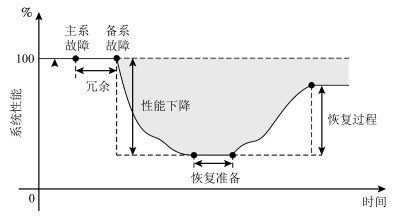



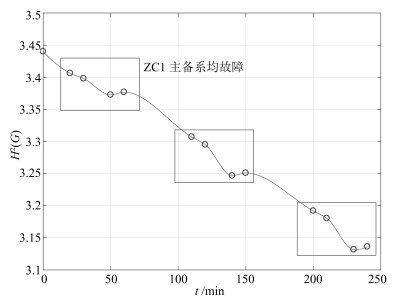




 下载:
下载:
